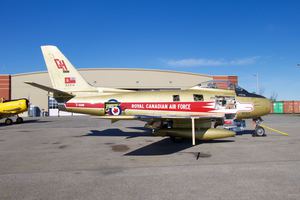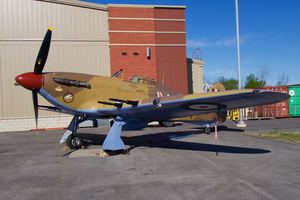Canadian Aviation and Space Museum Reserve Hangar Tour
- Details
- Written by Kevin Horton
- Hits: 2899
I was on Ebola standby today (yes, Transport Canada still has aircraft crews in Ottawa and Winnipeg on standby, every day, to fly trained medical specialists to assist local staff if a confirmed Ebola case is found). That meant that I had to stay reasonably close to the main airport at Ottawa, so I could be airborne within two hours if needed. So, no RV–8 flying today :(.
Instead, I did a tour of the Reserve Hangar at the Canadian Aviation and Space Museum. The Reserve Hangar is used to store aircraft that are not currently on display. As such, it is jammed full of many interesting aircraft. The tour was part of the Ottawa Doors Open weekend, when over 120 buildings that are normally closed to public are available for public tours.
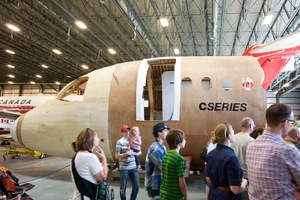 I was surprised to see this wooden mockup of the forward fuselage of the Bombardier CSeries. I didn’t think that anyone was making wooden mockups in this modern age, but apparently even fly-by-wire aircraft are designed using some ancient methods.
I was surprised to see this wooden mockup of the forward fuselage of the Bombardier CSeries. I didn’t think that anyone was making wooden mockups in this modern age, but apparently even fly-by-wire aircraft are designed using some ancient methods.
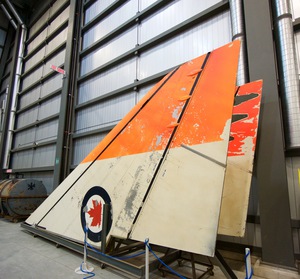 The outer wings of Avro Arrow RL203 are stored against the back wall.
The outer wings of Avro Arrow RL203 are stored against the back wall.
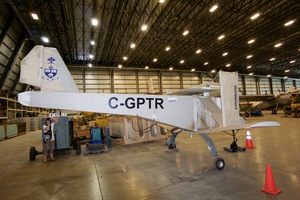 The remains of the University of Toronto ornithopter, which actually flew in 2006. The main flapping wings are not installed now.
The remains of the University of Toronto ornithopter, which actually flew in 2006. The main flapping wings are not installed now.
CSeries Flight Testing, and Lachute Lunch
- Details
- Written by Kevin Horton
- Hits: 3487
My trip to Wichita for the next phase of CSeries flight testing finally took place over last weekend. I flew down on Thursday, then drove up to Salina where the test aircraft had deployed (Salina is an old USAF Strategic Air Command base, with a long runway, so it is perfect for runway performance testing). We reviewed test results from the Bombardier testing on Friday morning. The winds in the afternoon were much lower than forecast - almost calm instead of the expected 10 kt, so we took advantage of the surprise opportunity to get our testing done. The winds stayed calm, so we were done by the end of the afternoon. We reviewed the data from our tests on Saturday morning to confirm that we hit the test conditions, and that the results were acceptable. Sunday we flew home. I had expected it would take a week or more, as it is very difficult to find light winds in Kansas in the spring.
The weather today was excellent, and I hadn’t gotten a day off last weekend, so I didn’t feel at all guilty about taking today to go flying. I zipped over to Lachute, Quebec (CSE4) to check out the small restaurant on the airfield, to see if it would be a good place to bring Terry for lunch someday. The food was perfectly adequate - I’ll let her make her own decision on the menu.
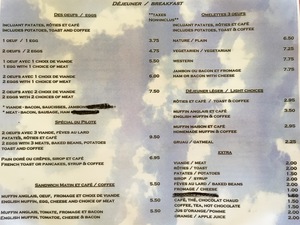 Casse Croute Des’Airs menu page 1
Casse Croute Des’Airs menu page 1
Vintage Wings Fly-In Breakfast
- Details
- Written by Kevin Horton
- Hits: 3686
I was supposed to be heading to Wichita on Friday, but that blew up at 5:00 when I checked my phone for messages that had arrived overnight. It turned out that they had discovered a snag with the test aircraft, and it would take a couple of days to set things right, and the weather forecast suggested that the short-lived good weather window would be gone by the time they were ready to go again. The type of testing we are doing requires quite low winds, so it can take quite a bit of waiting to finally get the right conditions.
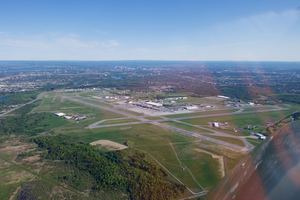 I took advantage of my unexpected weekend in Ottawa by flying to the Vintage Wings Fly-In Breakfast this morning. The weather was pretty much perfect, except a bit cool. It was smooth as silk for the flight over, and Ottawa Tower was happy to have me fly right over the airport at 2500 ft, as I zipped towards Gatineau.
I took advantage of my unexpected weekend in Ottawa by flying to the Vintage Wings Fly-In Breakfast this morning. The weather was pretty much perfect, except a bit cool. It was smooth as silk for the flight over, and Ottawa Tower was happy to have me fly right over the airport at 2500 ft, as I zipped towards Gatineau.
 The Spitfire XVI and Harvard IV were looking good in the sun.
The Spitfire XVI and Harvard IV were looking good in the sun.
Crosswind Practice and Grass Runway Test
- Details
- Written by Kevin Horton
- Hits: 3550
I didn't get flying on the weekend, as other things got in the way. Saturday was dedicated to finishing off a household plumbing repair. Sunday was the annual Smiths Falls Flying Club work day - we had an excellent turn out of people, and a long list of misc airfield and building maintenance items was completed.
It looks like I'll be on the road next weekend, and today's weather forecast was reasonably promising, so I booked a day off. Originally Terry and I planned to fly to Edenvale for lunch, but the winds were stronger than I expected, after yesterday's cold front passage, so I pulled the plug on that plan this morning. It would have been very bumpy at low altitude, and Terry does not enjoy that sort of thing.
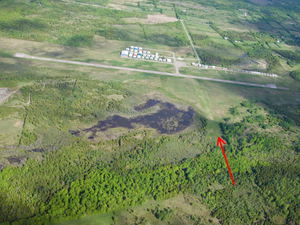 The winds at Ottawa were forecast to be gusting to 22 kt, roughly 70° off the axis of the runway at Smiths Falls, so It looked like a good day to do some crosswind practice.
The winds at Ottawa were forecast to be gusting to 22 kt, roughly 70° off the axis of the runway at Smiths Falls, so It looked like a good day to do some crosswind practice.
Smiths Falls also has an unoffical grass crosswind runway, roughly 1550 ft long, at 90° to the main runway (I calculated the length by comparing it to the 4000 ft long main runway in the Google Maps satellite image). It is not listed in any of the official publications, as it is not offiically maintained, and it is almost perfectly lined up with the clubhouse. The flying club uses it to teach students how to do short field take-offs and landings in the flying club C172s.
I walked the runway this morning, to confirm its condition was suitable, in case the wind strength increased after I took off, and I needed a more into wind runway for landing. I concluded that the runway condition was perfectly acceptable, but the west side of it was in better shape than the east side.
You can see the grass runway in this shot - the arrow is pointing to the south end of the runway.
 This shot is taken from the south end of the grass runway, looking north along the runway axis. The club house is visible past the far end of the runway.
This shot is taken from the south end of the grass runway, looking north along the runway axis. The club house is visible past the far end of the runway.
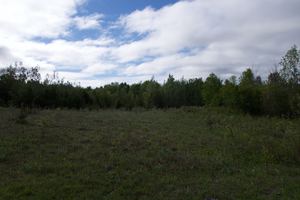 This shot, taken from the south end of the runway, facing south, shows the trees that you have to clear on final.
This shot, taken from the south end of the runway, facing south, shows the trees that you have to clear on final.
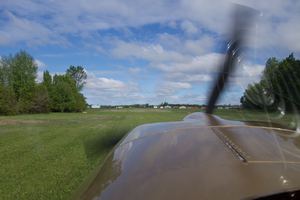 I did several take-offs and landings on the main runway, with the winds roughly 70° off, at 10 to 20 kt. Then I did one low approach to the grass runway to convince a few dozen Canada Geese to leave, then one landing and a take-off. The grass is a bit long, so there was quite a bit of rolling friction, which allowed me to stop about half-way down the grass runway, with no braking.
I did several take-offs and landings on the main runway, with the winds roughly 70° off, at 10 to 20 kt. Then I did one low approach to the grass runway to convince a few dozen Canada Geese to leave, then one landing and a take-off. The grass is a bit long, so there was quite a bit of rolling friction, which allowed me to stop about half-way down the grass runway, with no braking.
This is the view from the cockpit, just prior to starting the take-off roll.
ASI Check Out Flight
- Details
- Written by Kevin Horton
- Hits: 3648
I booked Thursday as a day off, as I was scheduled to be heading on the road on Sunday, for some flight testing. The weather was good, so I took full advantage with an RV-8 flight, the first one with the new airspeed indicator (ASI). It was quite turbulent, so it was hard to get an exact comparison with the airspeed indicator on the EFIS. Within the limits of accuracy imposed by the turbulence, it seemed like the new analog ASI was very close to the EFIS airspeed at normal cruise speeds, but it indicated roughly 5 kt fast during approach and landing. I intend to do a proper ASI instrument error check against a water manometer sometime in the next couple of months.
We got word on Friday that there was a two day delay in our travel, as the weather in Kansas has been poor, and the company had not yet finished their flight testing, so they are not ready for us to do our portion of this test phase. I just got another update a few minutes ago, and the poor weather has continued, so we have another two day delay, with the latest plan having us leave Ottawa on Thursday. At one point, I had hoped to fly the RV-8 to Yarmouth yesterday, returning home on Wednesday, but that got cancelled because I was supposed to head to Wichita on Sunday. Now, with Plan D, I won't be leaving until Thursday at the earliest, so I could have flown to Yarmouth after all, if only I had a better crystal ball. Drat.
ASI Replacement
- Details
- Written by Kevin Horton
- Hits: 3680
I needed to do some maintenance on the aircraft, and Saturday’s weather forecast had a front coming through, with wind and showers, so I decided that this would be a maintenance day.
I removed the original, damaged, “round dial” airspeed indicator (ASI), and replaced it with a new one purchased from Van’s Aircraft. The advantage of buying one from Van’s is it is delivered with the correct coloured arcs and red and blue ticks to match the airspeed limits of your model RV.
I was very glad to have installed an openable door on the aft side of the forward baggage compartment. That door provides good access to behind the instrument panel. Even with the door, it is still a pain in the butt to replace instruments, unless you have a helper. I didn’t have a helper organized, so after removing the damaged ASI, I inserted the new one blind - fortunately it was the same make and model as the first one, so the flange was a tight fit in the hole, and that held it in place. I scurried around to the cockpit, and was amazed to see that through blind luck I had inserted it at the exact correct angle so the four holes in the ASI were perfectly lined up with the screw holes in the panel.
 After replacing the ASI, I replaced all the quick-disconnect fittings in the pitot and static lines with Nylo-Seal fittings. I did a static system check, and found no leak at all in a one minute test. There was a very small leak in the pitot system, but it is way smaller than any pitot system leak limits I can find published.
After replacing the ASI, I replaced all the quick-disconnect fittings in the pitot and static lines with Nylo-Seal fittings. I did a static system check, and found no leak at all in a one minute test. There was a very small leak in the pitot system, but it is way smaller than any pitot system leak limits I can find published.

